Car navigation in detail
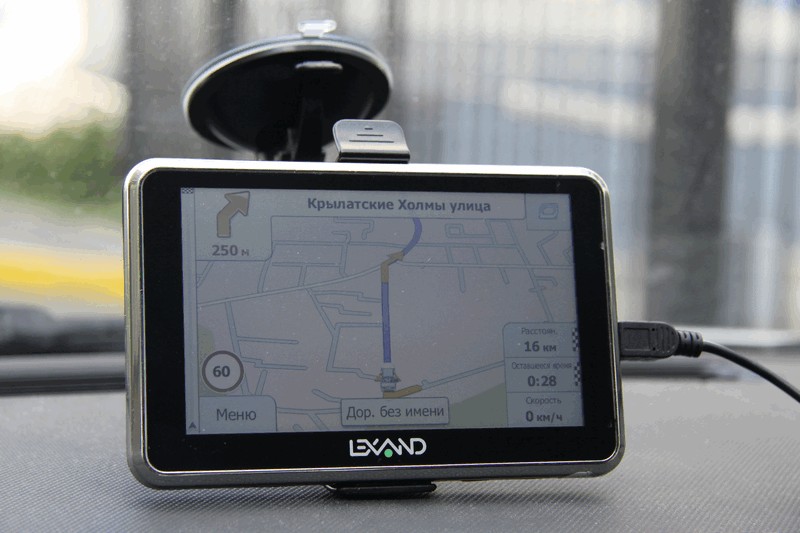
This article is for those who are going in the near future to buy a car Navigator, but lacks information.
For example, a typical Navigator Lexand Si-515 Pro HD I will try to elaborate what is now proposed on the market such devices.
Also describe the impressions of three of the tested navigation systems, one of which passed in June, about three thousand kilometres through two countries.
And at the end of the article will result in a large comparative table 23 current models of navigators Lexand, to show what can be possible in these devices.
The choice of now is large enough. Prices and performance, thanks to competition, differ not so strongly. Typically, when buying are interested in the reliability and usability of the device. The functionality and relevance of the cards of 100% define the installed navigation system. It is therefore very important to be able to update it easily, and even better if you can run several different.
the
Characteristics and specifications
So said Navigator runs on Windows CE 6.0 has a 5-inch screen high resolution 800x480, processor SiRFatlasIV 500Mhz, RAM 128MB, ROM 2GB, external micro-SD card, slim profile, 13 mm, and a slot for a SIM card.
Standard equipment: Navigator, the holder on the glass, stylus, charging from the cigarette lighter, USB cable, user manual. A nice bonus is the soft case.
Traditionally comes with one of three options for navigation systems: "Navitel Navigator", "PROGOROD" or "Cityguide". On my test were installed the first and second, plus I additionally put iGo.
the
Preparing the Navigator for the journey
As usual, the time charges was to spare, so I hastily tried to test the functionality of the Navigator the last night before departure. And, as if on purpose, I have that day refused to work USB connection. As I later realized, most likely because of the poor quality USB cable. In this regard, access to internal memory could not be obtained. And since Navitel has been written in ROM, not on the external card, fully update it I could not.
However, navigators Lexand are good that allow you to run any navigation program, just by specifying the path to the executable file. So I wrote on the micro-SD card checked iGo 8, which has successfully used on a PDA and on the other the Navigator Lexand ST-610, and tried to start it. But here was waiting for a surprise – the program get crashed with the message Access violation. In haste I tried several versions and they all refused to work with the same symptoms. It is likely that the problem is simple and related to preferences for working in 800x480 resolution, but to find out there wasn't time.
Remained the last option to try the new iGo Primo. I don't particularly trust, since the program is new, demanding on hardware, and, as I initially thought, not very stable.
But here was waiting for luck – all start on the first attempt! The system was so beautiful and comfortable that I immediately forgot all the previous torment. Recorded the last map of Russia (TeleAtlas) and Ukraine (Сarteblanche), made sure that the route was successfully laid (very important to do before leaving!) and went to sleep. Just in case as a backup to the Navigator, put it in the car PDAs with the old iGo 8.3.
the
Check in combat conditions
Trip Navigator proved excellent, never crashed and not lost in space. The only drawback – iGo somehow did not recognize day and night showing night colours in the day, even though I correctly set the time and time zone settings on your device. It managed to fix, changing hands night map settings on the daily.
The receiver catches satellites very quickly, even on cold start for about a minute. Accurate positioning time, I did not measure it, because until you start iGo and address selection he usually had time to sort out. The positioning accuracy is sufficient for the proper management on the route. In dense areas the signal is not lost.
Externally, the Navigator is indeed very thin (13 mm), lightweight and stylish. At Explay there are models with a thickness of 9 mm, but this, in my opinion, is not so much. In General, the design of all navigators Lexand, consistent and recognizable. He was quite successful, and change it big makes no sense.
Platform Windows CE 6.0, despite the moral obsolescence, is perfect for navigators. It is traditionally supplemented by a proprietary interface with large icons easy. The interface is adapted under management of fingers, but I feel the accuracy and responsiveness of the touch screen is a little weak.

Size 5 inch screen is sufficient for comfortable viewing of map driving. The map drawing speed is acceptable for resolution 800x480, although, of course, scaling in 3D is noticeably slow is better for this purpose to switch in the plane. I used to underestimated high resolution, but is now convinced that it is much better than the standard 480x272
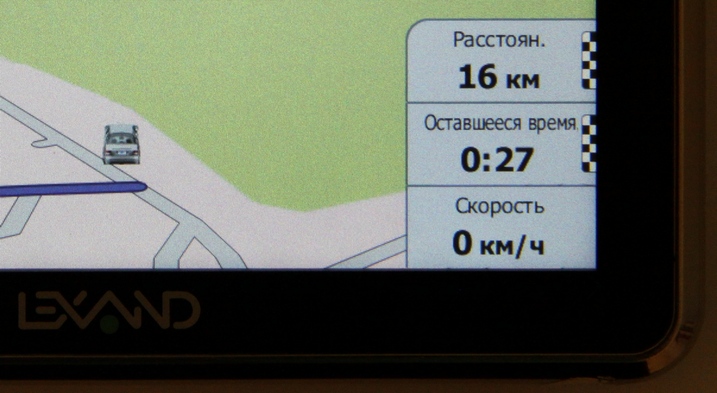
As you can see, even very small labels on the buttons in the lower right corner look perfect. On the display with a higher resolution map can be displayed in greater scale without loss of detail. This is a city with a dense network of roads in the route overview.
The display has anti-glare coating. In direct bright light the image, of course, fades, but to distinguish the map possible.
The second passenger, in this case, of course, almost nothing side can not see, but this is no great need:
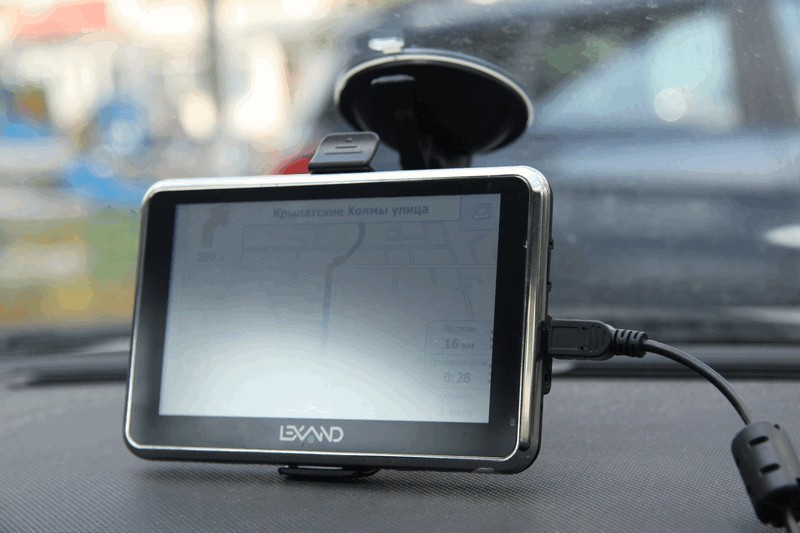
Since the screen is most likely a TN, the viewing angles are not its strong suit. However, when the direct sun on the screen does not fall, the picture looks soft. Anti-reflective coating works well.

I think it would not hurt protective film, although the screen is allegedly protected, in comparison with ST-610. To verify its crashworthiness, I, for obvious reasons, did not. Clicking sometimes noticeable shimmering crystals, and it creates a visual sense of fragility, although everything is stable.
While navigating a route, at least in iGo, there were no delays in the rendering and voice interchanges.
Light sensor I have not used, immediately remove the brightness to the maximum. At night, of course, it can be a toning down, but instead I used the night color scheme.
Mount, in my opinion, very comfortable. Suction Cup holds securely, and the mechanism is easily latched. I read somewhere that the device hangs on the bumps, but I fixed it so that the bottom of the Navigator depends on the torpedo, so it was firmly in place. The device itself is inserted into the mount until it clicks, and then can be very easily removed. The base can be left on the glass, although, perhaps, the bitter cold he will not benefit. About heat, I can say that I've stood 3 weeks in open Crimean sun, but with a suction Cup, nothing happened.

To adjust the position of the device can be in any plane through the hinge to the mount. After choosing the best angle, fix it with a special bolt.

Not a very comfortable thought the power button is hard to find, when the device is in the holder. And included it only after 2 seconds of clicking. Button on the left in the photo:

Once I began to show photos, here's the rest of the angles.
Bottom view: connector for SIM card.

The device has a stylus, though in most applications it is not needed. About where he might be useful,
will tell below.


Speaker Navigator is good, but on the maximum loudness rattles. I always put the volume on low, so he talked it down, because in the long journey is almost always someone of the passengers asleep. However, if you want to do a load, you can output sound to car speakers. Should be better, but I have not tried.
Charging by USB from the cigarette lighter or computer (plug one). It would be nice to have a network charge, but if necessary it is easy to buy extra.
Offline long enough, although I'm not exactly measured. Decent battery — 1450 mAh. Claimed to work up to 2 hours with maximum backlight and 4-x — minimum.
the
add or update navigation software
Lexand has long made very obvious and easy thing: staff can run any navigation software. In case of problems with one in the journey, you can just start another that is either more stable or has the best map in your area. And they wrote a simple shell MobileNavigator with shortcuts to the most popular navigation software. It is configured in a text file where you simply list the paths to all desired programs on the memory card and ask them labels. I have after the trip thought that the way to run any program, not just navigation. It looks like this:
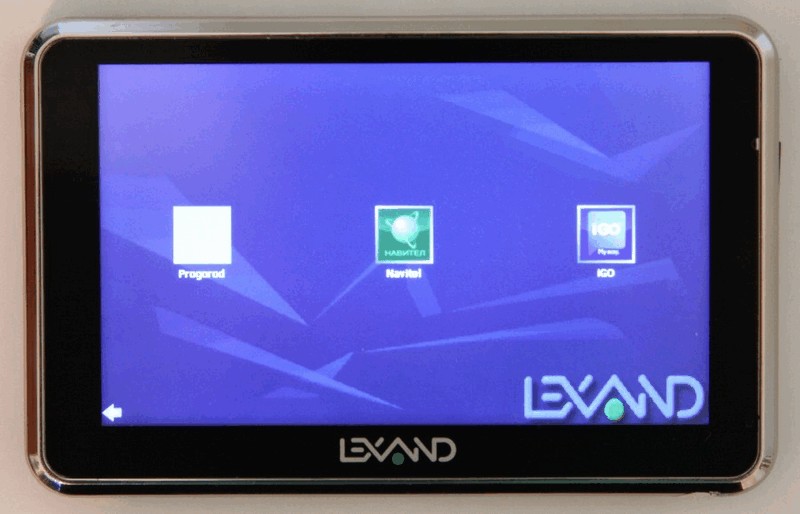
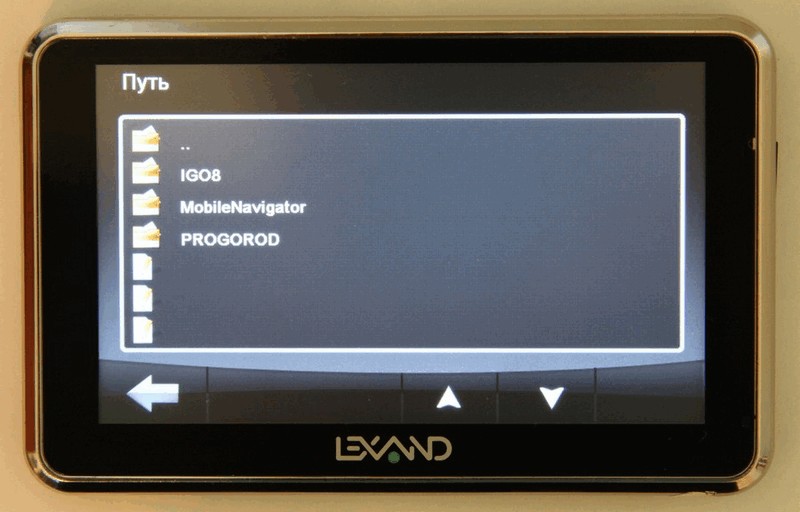
Unfortunately, even such simple shell were two minuses. First, close the window MobileNavigator is very difficult – a small arrow in the bottom corner is so small that to get through it without a stylus is almost impossible. Besides, it seemed to me that the accuracy of the clicking in the corners of the screen worse. And, secondly, as you can see in the screenshot, the first tab is not displayed. I tried to rearrange them in the configuration is still a problem with first. Developers, please correct this annoying bug, please.
The device 128 MB of RAM allows you to run almost any heavy navigation system. 2 GB built-in memory can record weighty Navitel, and still have room for a couple of other, more compact systems. And if you install the micro-SD card (supports up to 16GB), if you wish, you can take with you maps of the whole world.
Before something to test and try to find defects, it would be good to update all systems to the latest versions. The firmware of the Navigator I have not updated and do not quite understand, can it be done outside the service center. But the navigation software can be updated.
As I mentioned, the USB connection I have to work initially refused, and since Navitel has been written in the internal memory, update it, then I couldn't. Did it after the return, plugging in a normal USB cable.
Offers a choice of 2 connection options: USB Mass Storage and ActiveSync. However, a menu with those options buried deep in the bowels of the interface:
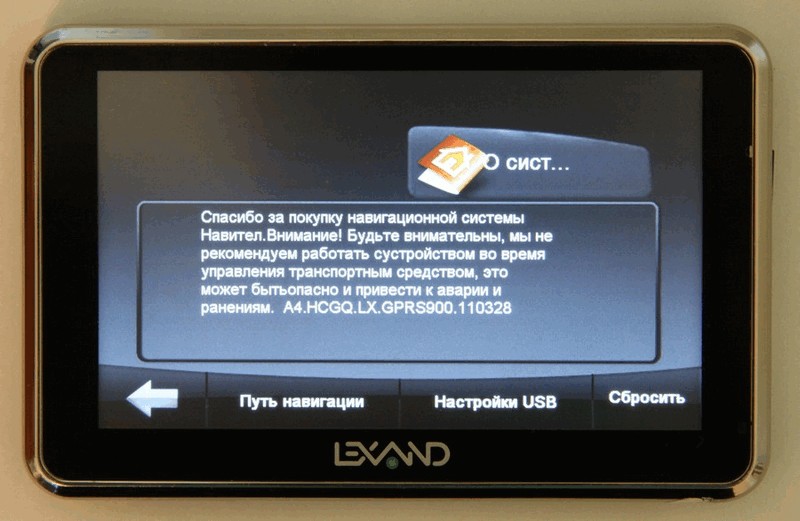
I apologize for the screenshots from the camera — I tried to put the program MyMobiler, which is perfectly copes with it. But before you start she needs to set a mate to the device and to do this it somehow failed. There may be some protection, I did not understand.
In ActiveSync mode see the operating system files, and the internal memory is in DataFlash folder. In USB Mass Storage mode, we get on the computer two connected section showing internal memory and external micro-SD card.

Copy speed over USB with the internal memory of the device 4-6 MB/s with external – 6-7. Quite decent and more than enough for software updates.
The device was installed "PROGOROD" 2.0.3037 with 2.0.017.20101210 and maps "Navitel Navigator" with the map 3.5.0.1702 for 2010.08.10.
To update Navitel was not so easy. You must first register your device on their website and enter the license number, then you will be able to download the program from your personal account. I was surprised that the version numbers of the app for different devices Lexand different. Navitel 5-key for Lexand was announced in March 2011. I downloaded and installed a version 5.0.0.1258. Fresh card format NM3 downloaded separately.
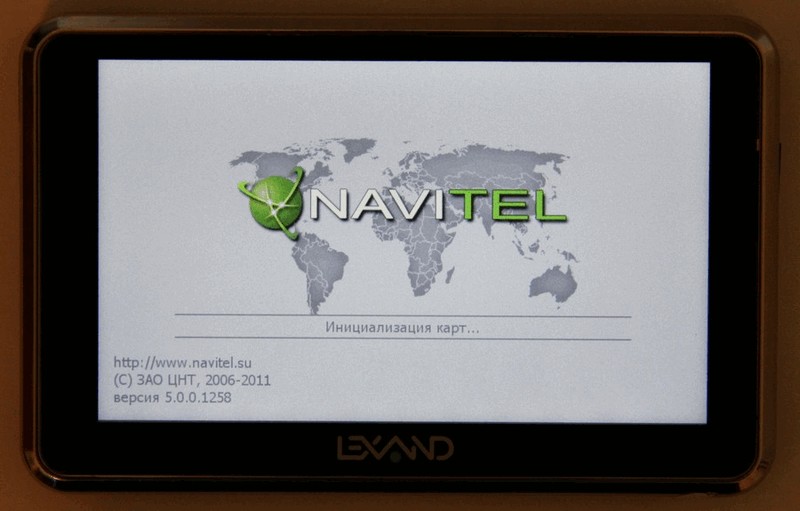
With PROGOROD turned out to be easier. The site has the latest version 2.0.3044 cards 2.0.022 from 31.05.2011. Download it and write to the SD card or in ROM, deleting the old version and review the license file.
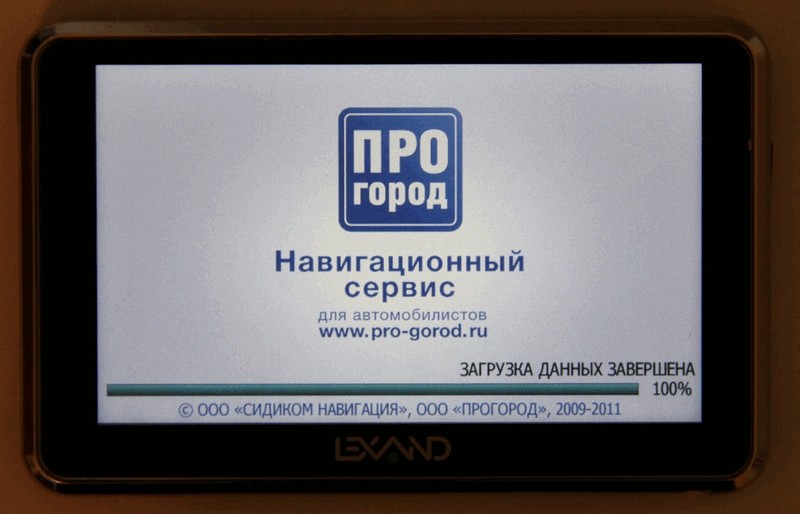
Cityguide put did not become, licenses it was not in the kit. For reviews, they lead to as navigation in the Northwest region.
Just in case will mention that if you have a license all upgrades are free.
the
Test and compare navigation software
iGo Primo
Can't help it, but I like iGo more any other navigation software. Speed, excellent support along the route, quick address search (virtually no delays), well-designed interface with a minimum of garbage on the screen and no unnecessary thingies, quick routing, stable job for me here everything is perfect. A version of Primo is easier although I expected that she will slow down and will be unstable.
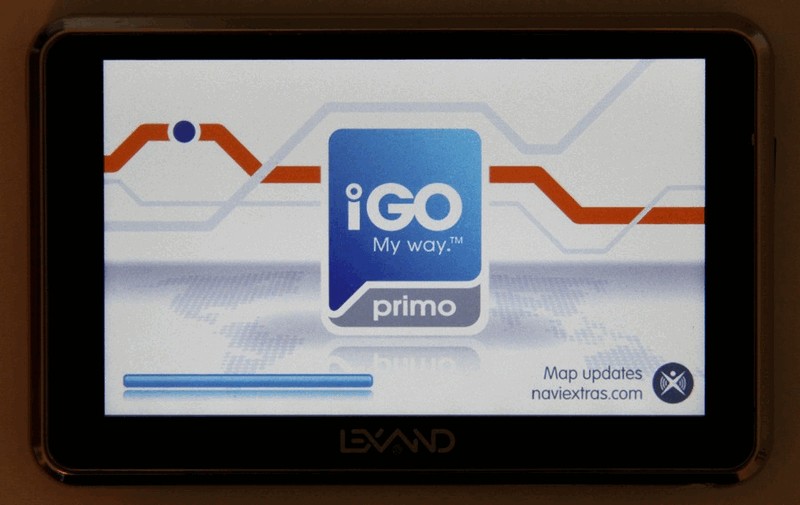
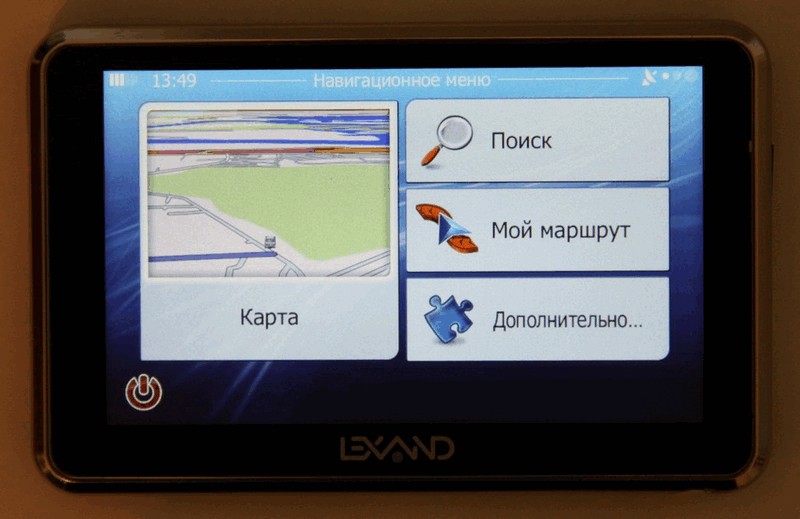
iGo is very user-friendly menu:

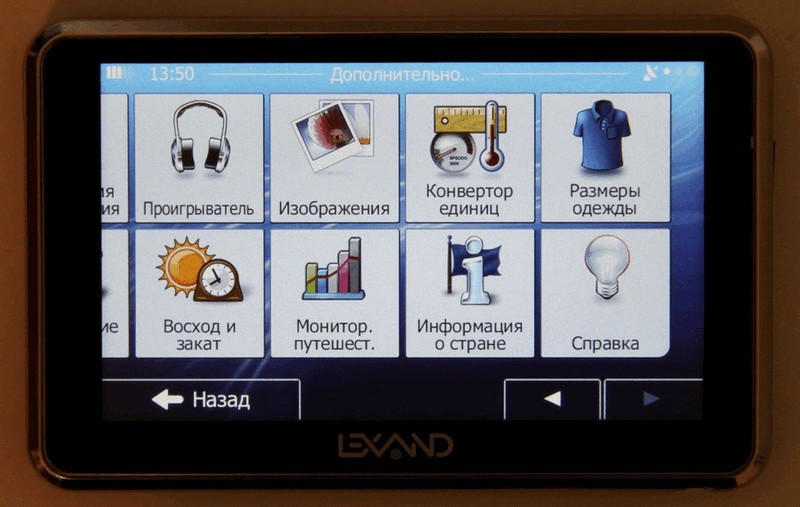
And the convenience of display card to him, in my opinion, no equal:

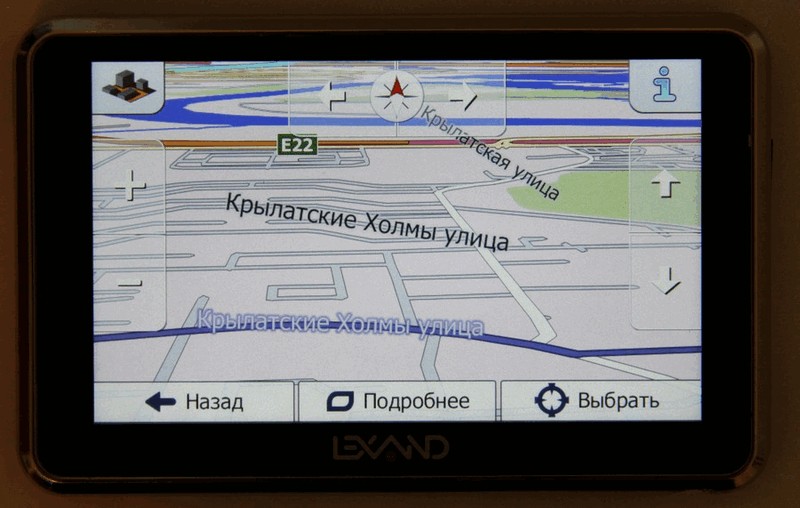
But I tried not to biased estimate quality and Navitel PROGOROD.
PROGOROD
PROGOROD I tried that about a year ago. Since the interface has changed radically. He became more comfortable, similar to the iPhone:

It is seen that the work is very active. Even after updating with 2.0.3037 to 2.0.3044 interface improvements were noticeable.
But I have to mention about the unfortunate thing: I have it quite often back in the day. Mostly it occurred when calculating the route and once when closing the program. And after updating the situation, unfortunately, has not improved. Here several times use the stylus to press the Reset. I don't know what the cause of these lockups. Hardly the fault of the Navigator with their hardware, because iGo and Navitel worked steadily. Guys, try to improve the stability of your system, and it will have all chances to become the most successful among Russian developments.
I traveled a little bit with PROGOROD-th in Moscow a couple of times and found the problem with the cards: he offered to turn where it was possible to go only directly.
Speed looks very good. Slows down a little when typing the address, but you can live.
When you first start with the default settings it gave me are so cluttered map that to navigate the route after iGo was very difficult. Had to disable the display of the houses and some other Goodies, after which it became much easier and faster. I do not understand why you need a home on the map, and even more three-dimensional. Absolutely, you can perfectly do without them. They only interfere with the perception of route when driving, closing the road from the driver. Although, sitting in a chair at the computer, the developers apparently think that houses more comfortable and beautiful.
Here is the display of three-dimensional junctions are really useful, especially for multi-level complex intersections.
There is a small observation to the interface: why hold such a large area of the screen under the buttons and making the button small and not clear:
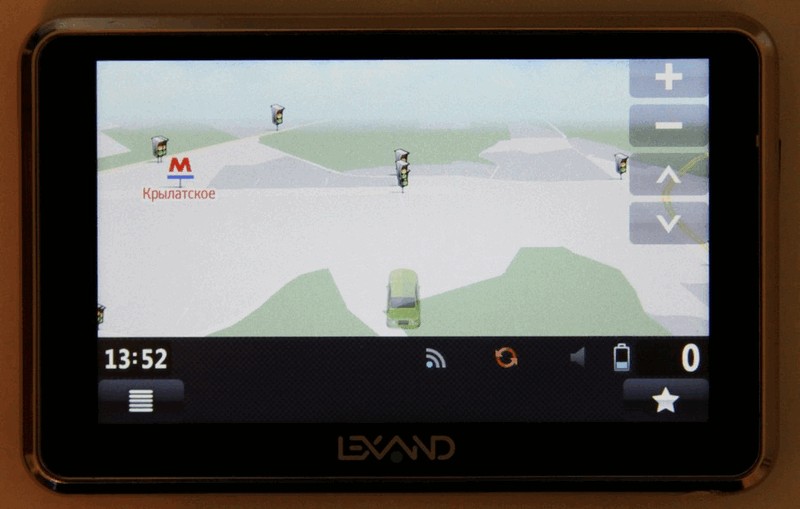
for Navitel Navigator
Now, about Navitel. I tried it already not the first year. Before he quite often freezes and generally was slow and unstable. In the latest version of stability, things are much better. In my opinion, he never I did not hang.
But they have another problem – speed. What is most annoying is the brakes at a set address. After clicking the next letter appear a sand clock somewhere for 1-2 seconds. Also, you never went behind the wheel? Can you imagine that sometimes it is necessary to move in heavy traffic to dial? Do the database search in 3 thousand names of streets in Moscow must take a lot of resources from the 500-megahertz processor? Another very surprised the necessity to print a dot and a space between house number and case. Although it was only in version 3.5, in 5th finally realized the uselessness of these taps.
About the display card is, of course, on the fan, but I Navitel not very much. The screen is cluttered with unnecessary buttons of different sizes and styles. Tell me why the driver letters with shadows? Why blurred maps on the horizon? The route is drawn quite crooked lines. Better throw more force into the rendering. Because sometimes it's just a nightmare – constant jerking and flashing the entire screen with all labels and house numbers.
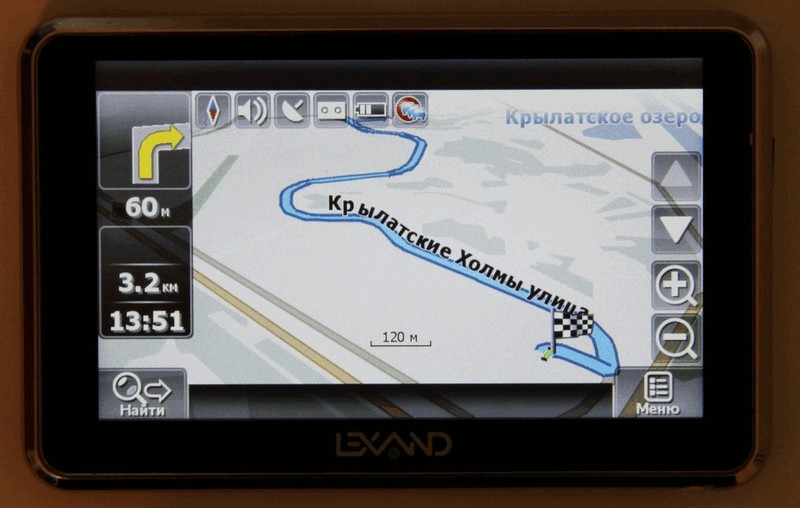
For car Navigator is the most important thing is a simple and fast interface. Everything else is secondary. The driver usually has no time to look at all the prettiness. A glance at the screen should take no more time than in the mirror. During this time, must find time to read and understand all the important information.
But the App has one big advantage: a great map of Russia, judging by the reviews on specialized forums. Here, indeed, is actively working on the improvement and clarification. And, of course, the mirror service. Unfortunately, I only had time to make sure it works, but not used.
Finally, I propose to compare the size occupied by the distributions of these programs:
the
-
the
- PROGOROD maps of Russia: 500 MB the
- Navitel maps of Russia: 1770 MB the
- iGo Primo with maps of Russia and Ukraine: 207 MB
Yes, iGo is also a three-dimensional house and even maps of the landscape. And they take a huge amount. But they can be supplied separately on request. To navigate the silhouettes of houses, which, I assume, eat up the most space, is not necessary. You need only one address and coordinates.
the
GSM/GPRS
From Lexand there are 3 models with support for SIM-cards (index Pro), but 515 Pro HD is the only one with high resolution. For those who don't need GSM, there are some models with support tubes via Bluetooth.
Without a SIM card navigation works well despite the reviews. Apparently, the firmware fixed, although the website is still hangs problem report.
When you turn on with inserted SIM card is prompted for a pin code, but how to do it – the move is unclear. I even spent half an hour on the Internet, yet guessed that it is necessary to open GPRS on the 2nd level of nesting the menu, which for some reason are always active, even when the inserted SIM card.
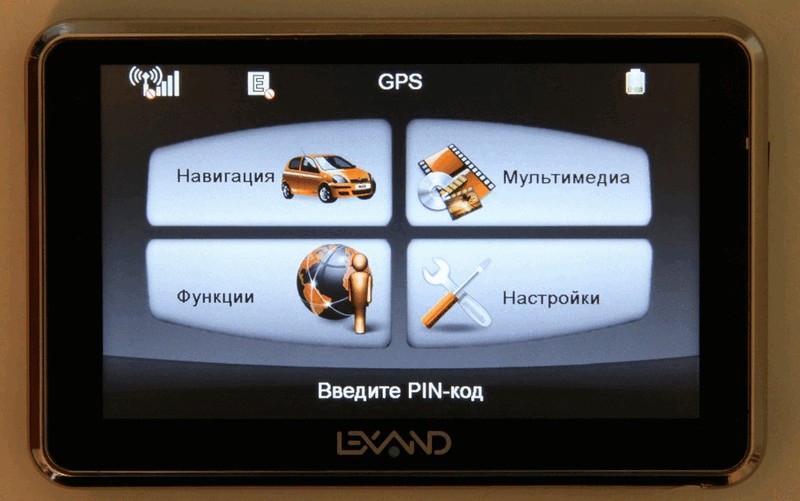

The SIM card gives the Navigator a few useful features. First, is the ability to load the tube in real time. Perhaps this is the most important and obvious function. But even here you can do with a phone with Bluetooth.
Everything else, in my opinion, minor. Yes, it is convenient to call and send SMS in a trip to the big screen and on-screen keyboard. However, if the dialing is implemented in Lexand good,
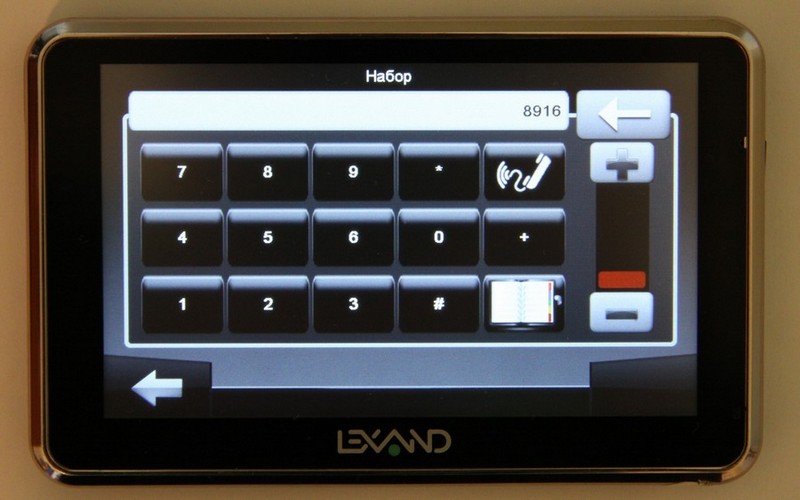
SMS is used for standard microscopic keyboard Windows CE, which you can only press with the stylus.

As for the Internet, I would never use it, if I had a any laptop, tablet or even smartphone. On Navigator installed some ancient Internet Explorer, probably going with regular Windows CE. To do anything in it without a stylus is impossible: all the same on-screen keyboard, and when typing SMS, the wretchedness of the interface and almost complete inability to close the browser window close button is microscopic and, moreover, almost never pressed on the first attempt due to poor screen sensitivity in the corners. Missed some hardware button "Back".
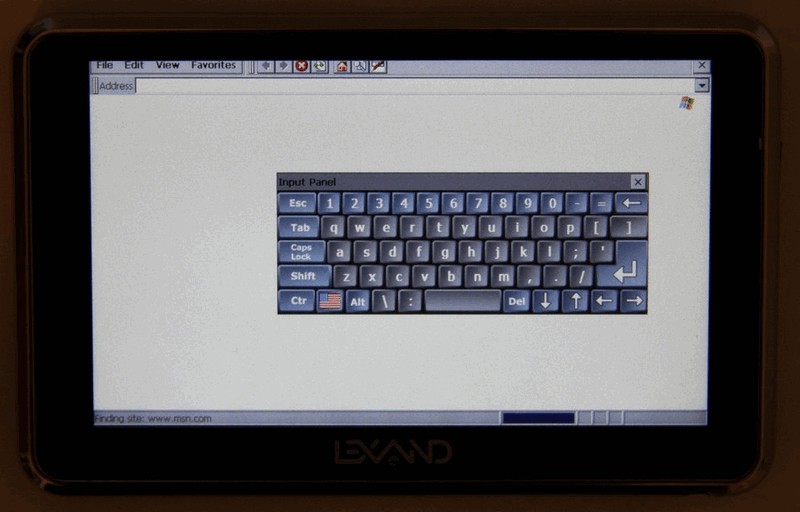
The Internet for some reason was terribly slow. Even the Lite page of Yandex (ya.ru) opened a minute. I thought it was because of the unstable connection in the apartment, however, the MTS-ovsky a 3G modem sticking out next to the computer, worked perfectly. There are 2 options: either the device is very poor GSM antenna, GPRS our operators really so slow and overloaded. People, how do you manage to properly use Yandex maps with phones without 3G?
In General, I repeat: GSM/GPRS Navigator needed only for receiving tubes. And even in this case, because of the terrible quality GPRS may be preferable to use Bluetooth because the phone is with 3G works much better.
the
secondary functions
Function of viewing of video, music, photos and texts in all browsers traditionally very poor and slow. There they were, most likely, for show, so I will not detail them here.

Sound with the Navigator you can display via the built-in FM transmitter on-Board the acoustics of the car, adjusting the GPS data and your FM receiver in the vehicle the same frequency.

I do not restrain myself once again not to mention iGo. In version Primo has built-in tools for working with multimedia. They are made in the style of the iGo, i.e., beautiful and conveniently:

From their appearance, the iGo can be used as a complete shell of the Navigator, running it at system startup. Although the choice of navigation system it is better to leave.
the
Insights
Lexand quite active on the market of navigation devices, releasing devices, features the latest. The main thing – not to make mistakes with the quality, which can affect reputation. All declared functions work perfectly, or they do not worth implementing.
So, briefly the pros and cons of Lexand Si-515 Pro HD.
Advantages:
the
-
the
- High resolution screen the
- GSM/GPRS Module DYA receiving tubes the
- Comfortable fit the
- Staff can run any navigation system the
- the Amount of RAM 128 MB is enough for heavy navigation systems the
- a Quick orientation to the satellites the
- FM transmitter the
- battery capacity
Disadvantages:
the
-
the
- Not very responsive resistive screen the
- minor flaws in the original shell Lexand the
- there is No AV-IN to display the image from the rear camera (available in other models Lexand) the
- Flaws with the Internet browser and SMS the
- do Not quite understand the problem with the USB connection — I suspect a poor wire the
- Multimedia capabilities more for show; it would be good to give the ability to run third-party multimedia programs.
In General, the better, but any fatal flaws I see. Next time, try to take the test some of the latest models with faster CPU, new design, and judging by the settings on the website, the more high quality screen.
the
a Comparison of a line of navigators Lexand
Unfortunately, the manufacturer does not publish on the website a comparative table of their models. Without such a comparison, anyone would be confused in the selection of the 23 variants. So I will try to close the gap.
All models Lexand have some common characteristics:
the
-
the
- card Support micro-SD up to 16GB the
- 128 MB RAM the
- Wi-Fi the
- the Ability to run any navigation system the
- In all latest models a headphone Jack of 3.5 mm, and in earlier – 2.5 mm.
Comparative prices are taken mainly from auto-gps.ru. The prices are not the lowest, but stock almost the entire range. Missing positions are complemented with Yandex.Market.

A good, reliable navigation and an exciting travel.
Комментарии
Отправить комментарий